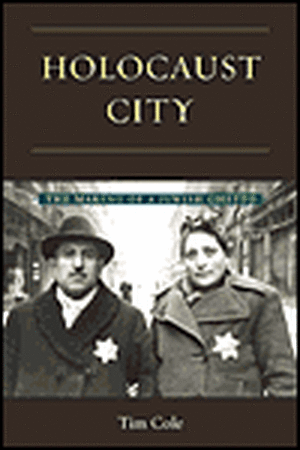Holocaust City: The Making of a Jewish Ghetto
Autor Tim Coleen Limba Engleză Hardback – 30 apr 2003
Preț: 1168.55 lei
Preț vechi: 1425.05 lei
-18% Nou
Puncte Express: 1753
Preț estimativ în valută:
223.64€ • 232.86$ • 188.100£
223.64€ • 232.86$ • 188.100£
Carte tipărită la comandă
Livrare economică 10-24 martie
Preluare comenzi: 021 569.72.76
Specificații
ISBN-13: 9780415929684
ISBN-10: 0415929687
Pagini: 320
Ilustrații: 10 b/w images and 10 color images
Dimensiuni: 152 x 229 x 19 mm
Greutate: 0.59 kg
Ediția:1
Editura: Routledge
ISBN-10: 0415929687
Pagini: 320
Ilustrații: 10 b/w images and 10 color images
Dimensiuni: 152 x 229 x 19 mm
Greutate: 0.59 kg
Ediția:1
Editura: Routledge
Cuprins
1. Architectural Solutions, Spatial Solutions and Final Solutions 1.1 Architectural Solutions 1.2 Spatial Solutions 1.3 Pariah Landscapes, Landscapes of Exclusion and Spaces of Domination 2. Asking Spatial Questions of Holocaust Ghettoization 2.1 The Ghetto as "Jewish" Place 2.2 The Ghetto as Holocaust Place 2.3 Ghettoization and the Question Why 2.4 Ghettoization, the Question Why and the Question Where 2.5 Ghetto Space, and the Ghetto as Place: Ghettoization and "Jewish Presence" and"Jewish Absence" 2.6 Territoriality and the Exercise of Power through Ghetto Space 2.7 Ghetto Walls, Ghetto Boundaries 2.8 Postscript: Defining the "Jew" 3. Holocaust Ghettoization and the Specifics of Time and Place: Hungary, 1944 3.1 The German Occupation and the Hungarian Holocaust 3.2 Trianon, the Nazi Alliance and Antisemitic Measures 3.3 The "Hungarian-ness" of the Hungarian Holocaust 3.4 Politics at the Local Scale - Budapest, 1944 3.5 Holocaust Ghettoization in Hungary and the Question Why 3.6 Ghettoization Texts - 7 April and 28 April, Ghetto Orders 4. Planning and Implementing Ghettoization, April-May 1944 4.1 Mapping out the Ghettoization Plans of 9 May, 1944 4.2 Presences and Absences at the City Scale 4.3 Presences and Absences at the Ghetto Area Scale 4.4 The Changing Meanings of Ghettoization, Late May, 1944 4.5 Contested Timing 5. Implementing Ghettoization, June 1944 5.1 Comparing Ghettoization as Imagined (9 May) and Ghettoization as Implemented (16 June) 5.2 The Demographic Context to Ghettoization 5.3 A Brief History of the Discourse of "Jews," Allied Bombing and the Budapest Ghetto, 1944 to the Present 5.4 Experiencing Ghettoization: the XI District 6. Contesting Ghettoization, June 1944 6.1 Five Sites of Contestation between "Jews" and "non-Jews" 6.2 Two Sites of Contestation between "non-Jews" 6.3 Three Sites of Coalition between "Jews" and "non-Jews" 6.4 The Impact of Petitioning upon the Doctors of Space 6.5 The Definitive Mapping of the Ghetto, 22 June, 1944 6.6 Experiencing Ghettoization: the XI District 7. Putting the "Jews" in their Place, May-June 1944 7.1 Territorial Solutions, Temporal Solutions 7.2 Top-Down, Bottom-Up 7.3 Contesting the Division of the City 7.4 Contesting the Division of Cinema Space 8. Planning and Implementing Hyphenated Ghettoization, July 1944-January 1945 8.1 Plans to Separate "Christian Jews" 8.2 Plans to Separate "Protected Jews" 8.3 Implementing Hyphenated Ghettoization during the Nyilas Period 8.4 The Making of the International Ghetto 8.5 The Making of the Pest Ghetto 9. Uncovering the Traces of Ghettoization, 1945 to the Present 9.1 The Pest Ghetto as Site of History and Site of Memory 9.2 The International Ghetto as Site of History and Site of Memory 9.3 Other Sites of History and Memory 9.4 Two Museums, Two Memories
Notă biografică
Tim Cole, a respected historian on the Holocaust, is Lecturer of European Social History at the University of Bristol. Cole has written widely on the topic and his previous book, Selling the Holocaust: From Auschwitz to Schindler, How History is Bought, Packaged, and Sold (Routledge, 1999), received wide media attention and critical praise.
